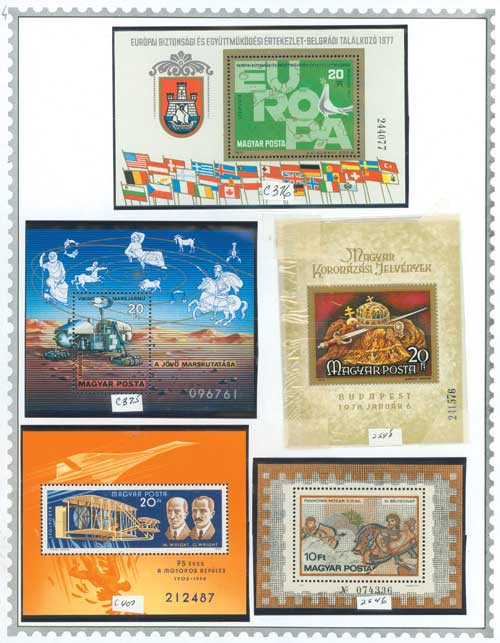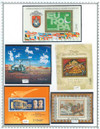
1871-2000 Hungary
# MA470 - 1871-2000 Hungary
$1,270.00
Impressive collection with 4,985 stamps on approximately 300 album pages. Mostly mint and nearly complete after 1950. Features many never-hinged stamps, Complete Sets and several nineteenth century"Crown of St. Stephen" types. Includes #1, #2 and #6 plus Airmails and semi-postals.
The central European country of Hungary is bordered by many countries: Romania, Yugoslavia, Austria, and the Ukraine. It was invaded and conquered in 896 by the Magyars, a nomadic warrior people who came from the Ural Mountains of Russia. The Magyars spoke, and still speak, a language that is related to Finnish. A small percentage of Hungarians continue the ancient nomadic tradition. They are the Gypsies whose way of life requires them to move from place to place.
Farmers grow crops similar to those of our Midwest Ð corn, wheat, oats, rye, potatoes, and sugar beets. Most of the farms are either owned by the State or are cooperatives, where the production and harvest is shared among its members. However, over half the population lives in cities and many workers are employed in the industrial center of Budapest, the capital of Hungary, and in a few other large cities. The Hungarian people still call themselves Magyars, and indeed, the majority of the population is just that. Their roots are ancient and very strong.
Hungary is mainly a country of low plains, and because it had no natural barriers for protection, its early history tells of repeated invasions by the Turks. In modern times, Hungary has been ruled by Austria, Germany, and Russia. It has been divided up among its neighbors and then put back together again, like a puzzle, more than once.
Allied with Germany in World War II, Hungary was occupied by Russian troops, the beginning of Soviet control. In 1956 during an anti-Communist uprising in Hungary, about 200,000 people left the country. But a few years later, over 60,000 returned. Despite its strict political and governmental policies under the communist regime, Hungary was a leading center of cultural reform and private ownership of business. In 1989, as many other Soviet-controlled governments gave way, so too did that of Hungary. Now a parliamentary democracy, Hungary faces the future with hopes of a better life for its citizens.
Read More - Click Here
Impressive collection with 4,985 stamps on approximately 300 album pages. Mostly mint and nearly complete after 1950. Features many never-hinged stamps, Complete Sets and several nineteenth century"Crown of St. Stephen" types. Includes #1, #2 and #6 plus Airmails and semi-postals.
The central European country of Hungary is bordered by many countries: Romania, Yugoslavia, Austria, and the Ukraine. It was invaded and conquered in 896 by the Magyars, a nomadic warrior people who came from the Ural Mountains of Russia. The Magyars spoke, and still speak, a language that is related to Finnish. A small percentage of Hungarians continue the ancient nomadic tradition. They are the Gypsies whose way of life requires them to move from place to place.
Farmers grow crops similar to those of our Midwest Ð corn, wheat, oats, rye, potatoes, and sugar beets. Most of the farms are either owned by the State or are cooperatives, where the production and harvest is shared among its members. However, over half the population lives in cities and many workers are employed in the industrial center of Budapest, the capital of Hungary, and in a few other large cities. The Hungarian people still call themselves Magyars, and indeed, the majority of the population is just that. Their roots are ancient and very strong.
Hungary is mainly a country of low plains, and because it had no natural barriers for protection, its early history tells of repeated invasions by the Turks. In modern times, Hungary has been ruled by Austria, Germany, and Russia. It has been divided up among its neighbors and then put back together again, like a puzzle, more than once.
Allied with Germany in World War II, Hungary was occupied by Russian troops, the beginning of Soviet control. In 1956 during an anti-Communist uprising in Hungary, about 200,000 people left the country. But a few years later, over 60,000 returned. Despite its strict political and governmental policies under the communist regime, Hungary was a leading center of cultural reform and private ownership of business. In 1989, as many other Soviet-controlled governments gave way, so too did that of Hungary. Now a parliamentary democracy, Hungary faces the future with hopes of a better life for its citizens.











